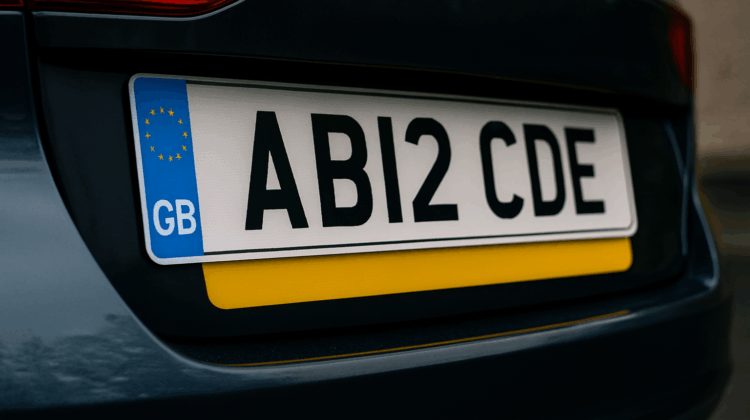
In the UK, number plates are more than just identifiers—they’re a critical part of road safety and vehicle regulation. One of their most important features is reflectivity. But why are UK number plates reflective, and what happens if they’re not? In this article, we’ll explore the science, the legal requirements, and the consequences of non-compliance, shedding light on a feature most drivers take for granted.
The Purpose of Reflective Number Plates
Reflective number plates are designed to enhance visibility, especially in low-light conditions. This isn’t just a matter of convenience—it’s a matter of safety and enforcement.
1. Improved Night-Time Visibility
Reflective materials bounce light back toward its source. When headlights hit a number plate, the reflective surface ensures the registration is clearly visible to other drivers, pedestrians, and law enforcement. This is especially vital during night driving, foggy conditions, or poor weather.
2. Support for ANPR Systems
Automatic Number Plate Recognition (ANPR) systems rely on cameras to read plates accurately. Reflective plates ensure that the characters are legible under various lighting conditions, allowing for effective traffic monitoring, toll collection, and crime prevention.
3. Emergency Situations
In accidents or roadside emergencies, reflective plates help responders identify vehicles quickly. This can be crucial when seconds count.
Legal Requirements in the UK
The reflectivity of number plates isn’t optional—it’s mandated by law. The DVLA and British Standards (BS AU 145e) set strict guidelines for plate construction, including reflectivity, durability, and legibility.
Key Legal Standards:
- White front plates and yellow rear plates: This colour scheme enhances contrast and visibility.
- Reflective background: Required for both front and rear plates.
- Non-reflective characters: The black characters must not reflect light, ensuring they stand out against the reflective background.
- BS AU 145e compliance: Since September 2021, all new plates must meet this updated standard, which includes tougher durability and reflectivity tests.
Failure to comply can result in fines, MOT failure, and even vehicle seizure in extreme cases.
What Happens If Plates Aren’t Reflective?
Non-reflective plates may seem like a minor issue, but they can lead to serious consequences:
1. MOT Failure
During your annual MOT test, number plates are checked for visibility and compliance. Non-reflective plates will result in an automatic fail, requiring replacement before the vehicle can be legally driven.
2. Fines and Penalties
Driving with non-compliant plates can lead to fines of up to £1,000. Police officers are trained to spot illegal plates, and ANPR systems will flag vehicles with unreadable registrations.
3. Insurance Issues
In the event of an accident, insurers may scrutinise vehicle compliance. Non-reflective plates could be seen as negligence, potentially affecting claims or liability.
4. Reduced Safety
Without reflectivity, your vehicle becomes harder to identify at night or in poor weather. This increases the risk of accidents and makes it harder for emergency services to respond effectively.
Common Causes of Non-Reflective Plates
Not all non-reflective plates are the result of intentional modification. Here are some common causes:
- Wear and Tear: Over time, exposure to sunlight, road debris, and cleaning chemicals can degrade the reflective coating.
- Counterfeit Plates: Some online sellers offer cheap, non-compliant plates that don’t meet UK standards.
- Customisation Gone Wrong: Enthusiasts may unknowingly choose styles or finishes that compromise reflectivity, such as tinted overlays or carbon fibre effects.
If you’re unsure whether your plates are compliant, it’s worth checking with a trusted supplier. At Regplates.com, we only supply plates that meet DVLA and BS AU 145e standards, ensuring full legal compliance and peace of mind.
How to Check Your Plates
Here’s a quick checklist to ensure your plates are up to standard:
- Are the characters black and non-reflective?
- Is the background white (front) and yellow (rear)?
- Do the plates reflect light when illuminated?
- Is there a supplier name and BS AU 145e mark?
- Are the plates free from cracks, fading, or peeling?
If you answered “no” to any of these, it’s time to replace your plates. You can explore our replacement number plates section for high-quality, compliant options.
Reflectivity and Personalised Plates
Personalised plates are a fantastic way to express individuality, but they must still meet legal standards. Reflectivity is non-negotiable, even for custom designs. At Regplates.com, we specialise in blending style with compliance, offering bespoke plates that pass all DVLA checks.
Whether you’re choosing a plate for your classic car, motorbike, or daily driver, our team ensures that every plate is reflective, durable, and road-legal.
The Future of Reflective Technology
As smart cities and digital mobility evolve, number plates may become even more sophisticated. Some countries are experimenting with digital plates that use e-ink or LED displays. While these innovations are exciting, they still rely on visibility and legibility—meaning reflectivity remains a core principle.
In the UK, any future plate technology will need to meet the same rigorous standards, ensuring safety and enforcement remain top priorities.
Reflective number plates are a small but vital part of the UK’s road safety infrastructure. They help drivers stay visible, support law enforcement, and ensure compliance with national standards. Neglecting this feature can lead to fines, MOT failures, and increased risk on the road.
Whether you’re upgrading to a personalised plate or replacing a worn-out set, make sure reflectivity is at the top of your checklist. At Regplates.com, we’re committed to helping you stay stylish, safe, and street-legal.

Jon Cherry is a Director of leading personalised number plate dealer Regplates.com. Jon has over 25 years industry experience handling some of the most expensive plates ever sold with many high profile and celebrity clients. Active since 1991 in the number plate industry, Jon is currently Chairman of the Cherished Numbers Guild, a trade body representing number plate dealers in the UK. Jon has written many articles on the industry and insight into the future of numberplates and the market as a whole.




